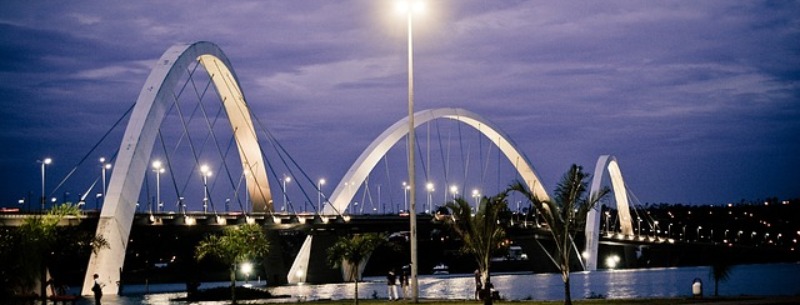Brasilia, capital city of Brazil
Brasilia is a feat of architectural design and urban planning. Designed in the 1950s as a planned city, the capital’s futuristic feel and marvelous buildings make it one of South America’s premier travel destinations. The city is like a living museum, and it has earned its prestigious designation as a UNESCO World Heritage site. It is the only city built in the 20th-century to receive that honor, and it is easy to see why. You can spend days exploring the city’s impressive monuments and buildings, but no matter how long you stay, it will never feel like enough in this wondrous city.
The city is divided by the Monumental Axis, a central avenue that is lined with many important monuments, government buildings and memorials. The Three Powers Plaza sits at the end of the axis and is surrounded by the National Congress, the Supreme Court and Presidential Palace. Designed by Oscar Niemeyer and Lúcio Costa, the plaza represents the harmony achieved when the three branches of government meet. The Presidential Palace is the most impressive of the three buildings, and it is open to the public on Sundays for guided tours.
The Monumental Axis is also home to the Cultural Complex of the Republic, including the National Library and the National Museum. The library’s collection includes more than 300,000 items, and the National Museum spans a 17,000 square-yard exhibition space that displays temporary art exhibits.
One of the most eye-catching sights on the axis is the Catedral Metropolitana. The dazzling design features waves of stained glass and 16 curved columns that represent hands reaching out toward heaven. The oval-shaped interior is graced by three suspended sculptures of angels, a blue, brown and white stained-glass nave and a reproduction of the Shroud of Turin.
For a sweeping view of the city, head to the top of the Television Tower, the highest point in the city at 715 feet high. The lower deck contains the National Museum of Gemstones, and a craft and food market takes over the base on weekend mornings.
The Juscelino Kubitschek Memorial sits at the western end of the Monumental Axis. The underground museum tells the story of Kubitschek, the optimistic president of Brazil who served from 1956 to 1961. Visitors can explore the leader’s personal objects, documents, photographs and pay their respects at his tomb.
The capital is home to many interesting museums. One of the most fascinating is the Monetary Museum, maintained by the country’s central bank. The vast collection includes rare coins, old machinery used to cut and print currency, gold bars, foreign currencies, medals and more.
Brasilia is also home to stunning natural beauty, including Paranoá Lake. Visitors can enjoy gorgeous views of the city and take in the fabulous colorful sunsets from the coastal chapel or swim, fish and snorkel the day away. Brasilia’s City Park is also worth a visit. Just slightly larger than New York City’s famous park, the Brazilian version is a favorite place for locals to unwind by jogging, skating, cycling, barbecuing and strolling.
There is never a bad time to visit the city, but one of the best times to come to Brasilia is during the Cinema Festival in October and November. The world-renowned festival is a celebration of Brazilian cinema and shows early screenings of both mainstream and independent films. The city also puts on an enormous and lively music festival each summer, the Porão do Rock. Local and international bands play side by side on the many stages, and a rock ‘n’ roll vibe permeates the whole city.
Brasilia Geographical Location
Brasilia is central to Brazil and is located towards the southeastern coast. It is the fourth largest city in Brazil and is home to a population of 2,600,000.
Brasilia Language
Portuguese is the official and most commonly spoken language in Brazil. Spanish, German, Italian, Japanese and English are spoken also but are much less common, usually as a second language.
Brasilia Predominant Religion
- 73.6% Roman Catholic
- 15.4% Protestant
- 1.3% Spiritualist
- 2% Other
- 7.7% None
In addition to the aforementioned religions, voodoo is also practiced by a percentage of less than 0.5% of the population.
Brasilia Currency
The Brazilian Real is the official currency of Brazil.
Brasilia Climate
Brasilia has a tropical savanna climate with dry summers. It is normally hot with no drastic temperature changes throughout the year.
Brasilia Main Attractions
- Parque Nacional de Brasilia
- Teatro Nacional
- Congresso Nacional
Other Attraction in Brasilia
- Juscelino Kubitschek Monument
- Catedral Metropolitana Nossa Senhora Aparecida
